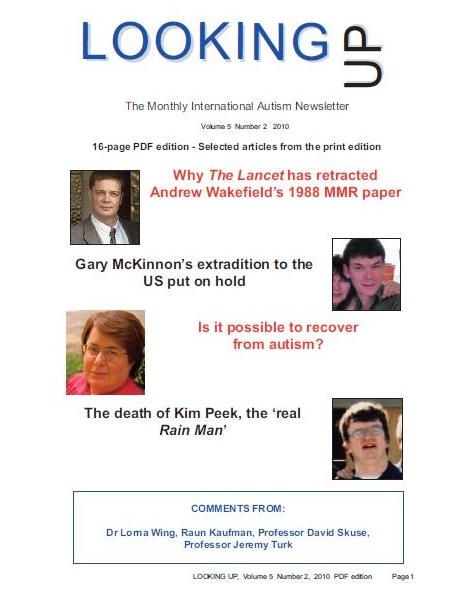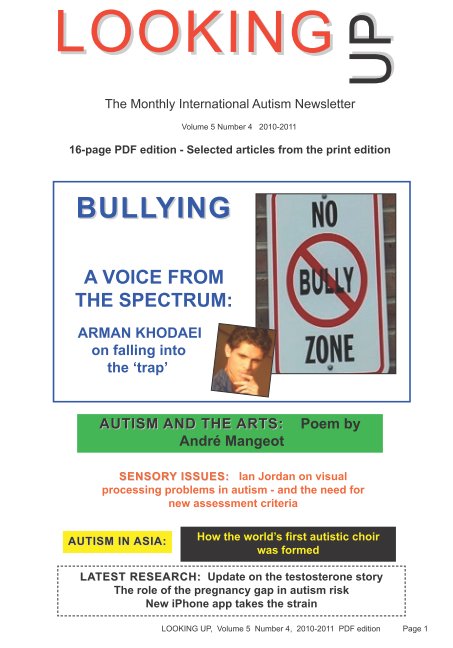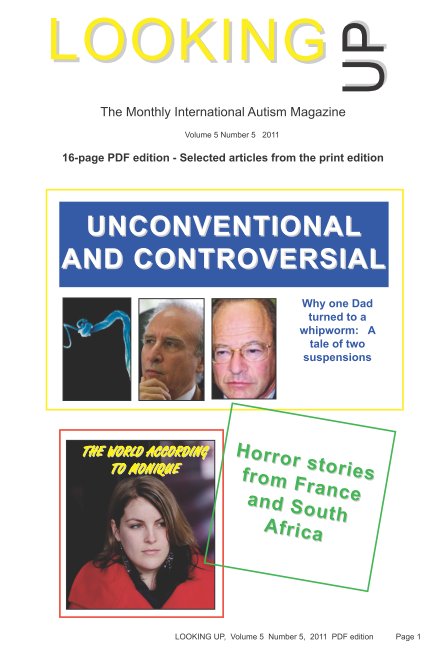Looking Up, 16-page English PDF Edition, Back Issues and Current Issue

|

|

|

|

|

|

|

|
| Home page | Subscribe (print edition) | Selected articles | Our publications | Our mailing lists |
| PDF edition | Subscribe (PDF edition) | Back issue contents | Autism books | Contact us |
From Volume 3 Number 12
DURHAM, North Carolina, USA: For the first time, researchers have identified an interaction between
two specific genes that increases the risk that a child will develop autism.
Both of the genes are associated with a chemical in the brain that has been a
target of autism research for the past decade.
"This is exciting because it tells
us that researchers seem to be on the right path and that we may be
starting to understand the brain pathology (of autism)," said Dr Andy
Shih, who is chief science officer for the National Alliance for Autism
Research, which helped fund the new study.
It is widely thought that autism
risk is determined by a combination of unidentified genetic and
environmental factors. Children born into families with one autistic
child are known to be at greater risk of developing autism, but the
extent of that risk is not well understood.
An autism researcher, Dr Margaret
Pericak-Vance, and colleagues with Duke University's Center for Human
Genetics in Durham, North Carolina, have long studied a brain chemical
associated with slowing or stopping nerve activity, known as GABA. The
GABA system acts as something of an information filter to prevent the
nerves from becoming overstimulated. It has long been suspected that
this filtering process is compromised in many autistic children.
Impairment of the GABA system could overwhelm the brain with sensory
information, leading to many of the behaviour traits associated with
autism.
GABA is believed to play a key
role in the early development of the brain, and the Duke researchers
and others have previously shown a connection between GABA and autism.
In their latest study, Dr
Pericak-Vance and colleagues examined 14 genes that help make parts of
the GABA receptor. The receptors allow the chemical to affect nerve
function …
To read the entire article you need to order this back issue

|

|

|

|

|

|

|

|
| Current 40-page print edition issue | |||||||||||||||
|---|---|---|---|---|---|---|---|---|---|---|---|---|---|---|---|

|
| ||||||||||||||
| PRINT EDITION BACK ISSUE CONTENTS AND FRONT COVERS | ||||||||||||||||||||||||||
|---|---|---|---|---|---|---|---|---|---|---|---|---|---|---|---|---|---|---|---|---|---|---|---|---|---|---|
| VOLUME 1, Number: | 1 | 2 | 3 | 4 | 5 | 6 | 7 | 8 | 9 | 10 | 11 | 12 | VOLUME 2, Number: | 1 | 2 | 3 | 4 | 5 | 6 | 7 | 8 | 9 | 10 | 11 | 12 | |
| VOLUME 3, Number: | 1 | 2 | 3 | 4 | 5 | 6 | 7 | 8 | 9 | 10 | 11 | 12 | VOLUME 4, Number: | 1 | 2 | 3 | 4 | 5 | 6 | 7 | 8 | 9 | 10 | 11 | 12 | |
| VOLUME 5, Number: | 1 | 2 | 3 | 4 | 5 | 6 | 7 | 8 | ||||||||||||||||||
| You can find our PDF EDITION CONTENTS AND COVERS on our PDF EDITION BACK ISSUES PAGE | ||||||||||||||||||||||||||
| Home page | Subscribe (print edition) | Selected articles | Our publications | Our mailing lists |
| PDF edition | Subscribe (PDF edition) | Back issue contents | Autism books | Contact us |